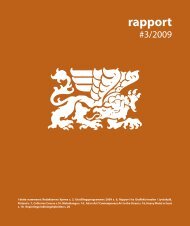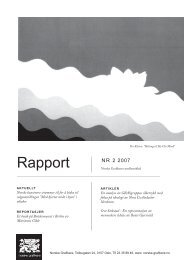Rapport nr. 3+4 2010-straight.indd - Norske Grafikere
Rapport nr. 3+4 2010-straight.indd - Norske Grafikere
Rapport nr. 3+4 2010-straight.indd - Norske Grafikere
Create successful ePaper yourself
Turn your PDF publications into a flip-book with our unique Google optimized e-Paper software.
Bernard Joisten, “Red castle”, 2009, wallpainting.<br />
Foto: Asbjørn Hollerud<br />
Aurélie Pétrel, “Falaise”, 2009, photographic<br />
installation, color photograph, PVC transparent<br />
adhesive film. Foto: Asbjørn Hollerud<br />
Bernard Joisten, “Forever More”, <strong>2010</strong>, duratrans,<br />
digital print, 118,4 x 179,5 cm. Multiple.<br />
Installation view at Shijo station, Karasuma<br />
subway line, Kyoto, Japan. Foto: Asbjørn Hollerud<br />
are produced by and for Super Window<br />
Project:<br />
2007: “Escapade”, Perrine Lievens.<br />
2008: “An exhibition of photographs”,<br />
Guillaume Leingre; “Circumnavigator’s<br />
paradox”, Mathieu Mercier ; “Eye of the<br />
Beyonder”, Item Idem.<br />
2009: “Red Jacket vs White Jacket”, Pierre<br />
La Police ; “Repetition”, Aurélie Pétrel ;<br />
“More”, Bernard Joisten ; “Forever more”,<br />
Bernard Joisten; “No man’s land”, (group<br />
show: Bernard Joisten feat. Shinichiro<br />
Arakawa, Guillaume Leingre, Mathieu<br />
Mercier, Aurélie Pétrel, Takashi Suzuki) ;<br />
“Pays Extérieurs”, Sandrine Pelletier. <strong>2010</strong>:<br />
“Folding Space”, Morgane Tschiember ;<br />
“Direction of Materials”, “Nissed”, Soshi<br />
Matsunobe ; “Bau”, Takashi Suzuki;<br />
Bouke de Vries; “The Show Must Go On”,<br />
Guillaume Leingre. Super Window Project<br />
publishes the “The Show Must Go on”<br />
review by Guillaume Leingre to be released<br />
in autumn <strong>2010</strong>. This work will be the final<br />
chapter of the first cycle of the programme<br />
(2007-<strong>2010</strong>) and will mark the beginning<br />
of second phase that will come to life with<br />
the conception of a new venue for Super<br />
Window Project. Or something else... We<br />
have 4 projects for 2011 that implies further<br />
connections between Japan and Europe. I<br />
want to break the walls of the gallery!<br />
AH: Is there any other galleries in Japan<br />
that are owned and run by a foreigner?<br />
BO: No! But there is Jeffrey Ian Rosen,<br />
director of Taka Ishii Gallery (Kyoto/<br />
Tokyo) and co-owner/ director of Misako<br />
Rosen (Tokyo). He is amazing and I admire<br />
him very much. Bold, great culture, eye,<br />
vision and very smart, fun and witty.<br />
AH: Do you get a sense of belonging to<br />
an art community in Japan?<br />
BO: Yes and no. People know me, know<br />
the boldness of the program, but I still<br />
Bernard Joisten, “Armory”, 2009, fiberglass,<br />
synthetic resin enamel paint, variable dimensions.<br />
Unique. Courtesy Super Window Project, Kyoto.<br />
feel like an outsider. First because I’m a<br />
foreigner and after almost 4 years I still<br />
do not speak Japanese... Unfortunately...<br />
Second, because my interests in arts, the<br />
way to present the program, to work,<br />
so close to the artists is quite a unique<br />
position here. I am trying hard to make a<br />
commercial break, to sell my artists here in<br />
Japan but in the meantime I also propose<br />
an alternative, something different<br />
because I am driven by a vision. Not by<br />
the market. Otherwise I would have never<br />
started a gallery in Japan. Nevertheless<br />
I feel intellectually close to some people<br />
here like gallerists like Taka Ishii, Takuro<br />
Someya, Hideki Aoyama, or curator Mami<br />
Kataoka (Mori Museum) who have a more<br />
conceptual and radical approach... but the<br />
art community is international, which<br />
is the Japanese paradox. Japan is not on<br />
the art map for many reasons... too far,<br />
too expensive, too socially complex... and<br />
with a huge language barrier. A place like<br />
Hong Kong with an art fair like ARTHK<br />
already secured its position as a central<br />
hub for arts in Asia, in just 3 years, in the<br />
very moment of a dramatic recession. Not<br />
Tokyo.<br />
AH: How do you pick your artists for the<br />
gallery? Do you look for a conceptual or<br />
visual coherence between them?<br />
BO: Not at the very beginning maybe...<br />
encounters, discussions with artists, other<br />
gallerists, curators, led me to make some<br />
choices... But now after almost 3 years, I<br />
think the coherence of the program gets<br />
more and more obvious, concise, focused.<br />
I guess the coherence of the program<br />
is me ! For the first 3 years, I wanted to<br />
build a story, each exhibition being the<br />
opportunity to write a new chapter of the<br />
book. I feel we really turned a page in 2009<br />
Baron Osuna. Foto: Asbjørn Hollerud<br />
with Aurélie Pétrel’s double exhibition and<br />
in <strong>2010</strong>, Soshi Matsunobe’s projects mark<br />
an evolution. From now on we will be<br />
more and more radical. We are aiming at<br />
something, something hard to define other<br />
than by art itself. As I said before, probably<br />
the coherence of the program resides<br />
mostly in the fact that the artists working<br />
with SWP are looking for something,<br />
formally and conceptually and it is great<br />
to be part of this exchange, this challenge.<br />
I also see that architecture shaped my<br />
Bernard Joisten, “More” (left to right) : “Mask<br />
2.006” (45 x 65 x 20 cm), “Mask 2.003” (60 x 65 x 20<br />
cm), “Mask 2.005” (60 x 60 x 20 cm), “Mask 2.007”<br />
(50 x 60 x 20 cm), “Armory” (variable dimensions),<br />
2009. Foto: Asbjørn Hollerud<br />
foreseeing. Architecture intended as a<br />
structure of thinking. Probably this is<br />
something very central and part of the<br />
Morgane Tschiember, “Folded Space”, <strong>2010</strong>, steel, enamel paint, mirrors, Japanese stone, variable<br />
dimensions. Unique. Courtesy Super Window Project, Kyoto. Foto: Asbjørn Hollerud<br />
coherence points towards that direction.<br />
A coherence that is more conceptual than<br />
visual. I also believe that artists do not<br />
belong to me or to the program. They’re<br />
free to go, to work with other galleries... as<br />
well as we can work with other galleries or<br />
“entities” too. It’s all about sharing a vision.<br />
AH: How is the Japanese contemporary<br />
art scene different from the European<br />
scene?<br />
BO: It is dramatically different. The<br />
main reason is that Japan is an island,<br />
with a powerful barrier: language.<br />
European capitals are all connected. 2<br />
hours maximum of flight between major<br />
places, powerful artists, museums, art<br />
centers, curators, collectors, magazines<br />
and galleries that shaped the 20th<br />
century history of art alongside with<br />
Americans... plus some of the biggest<br />
and most challenging art fairs : Art Basel,<br />
Frieze, Fiac, Art Forum, Artissima which<br />
we will be part of next November with a<br />
group show (Mathieu Mercier, Morgane<br />
Tschiember, Perrine Lievens, Bouke de<br />
Vries, Sandrine Pelletier, Soshi Matsunobe,<br />
Guillaume Leingre).<br />
AH: How do you feel about running<br />
a gallery in the traditional Kyoto<br />
compared to the high speed Tokyo?<br />
BO: I feel lucky to be part of something new<br />
happening in Kyoto. Since I started, Taka<br />
Ishii, Tomio Koyama, Kodama moved to<br />
Kyoto. Collector Naomi Rowe opened eNarts,<br />
Megumi Matsuo reopened in a huge<br />
space, Kohei Nawa developed Sandwich...<br />
Kyoto is turning into a cultural city, where<br />
2 art fairs bloomed this year, Art Fair<br />
Kyoto, and Ultra Kyoto. Being member of<br />
Ultra Kyoto, I can tell you that it will be<br />
held next year too and promise a lot of<br />
surprises.<br />
AH: What other galleries in Japan do<br />
you recommend?<br />
BO: Takuro Someya Contemporay Arts<br />
and Aoyama Meguro, both in Tokyo.<br />
Younger generation of galleries, promising,<br />
fresh and very adventurous.<br />
AH: What are the future plans for Super<br />
Window Project?<br />
BO: Keep eyes and brain wide open.<br />
Evolve. Break the walls.<br />
10<br />
11





